Page 1135 - Saunders Comprehensive Review For NCLEX-RN
P. 1135
3. Assess extremities for adequate neurovascular status.
4. Encourage coughing and deep breathing and the use
of incentive spirometry.
5. Assess pain and administer prescribed analgesics.
6. Monitor for incontinence.
7. Monitor for signs and symptoms of infection.
8. Monitor for superior mesenteric artery
syndrome (caused by mechanical changes in the
position of the child’s abdominal contents during
surgery) and notify the PHCP if it occurs; symptoms
include emesis and abdominal distention similar to
what occurs with intestinal obstruction or paralytic
ileus.
9. Instruct in activity restrictions.
10. Instruct the child how to roll from a side-lying position
to a sitting position, and assist with ambulation.
11. Address a potential body image disturbance when
formulating a plan of nursing care.
IV. Juvenile Idiopathic Arthritis
A. Description
1. Autoimmune inflammatory disease affecting the joints
and other tissues, such as articular cartilage; occurs
most often in girls
2. Treatment is supportive (there is no cure) and
directed toward preserving joint function, controlling
inflammation, minimizing deformity, and reducing
the impact that the disease may have on the
development of the child.
3. Treatment includes medications, physical and
occupational therapies, and child and family
education.
4. A pediatric rheumatology team can manage the
complex needs of the child and family most
effectively. The team may consist of a pediatric
rheumatologist, physical and occupational therapist,
social worker, and nurse specialist.
5. Surgical intervention may be implemented if the child
has problems with joint contractures and unequal
growth of extremities.
B. Assessment (Box 39-2)
1. There are no definitive tests to diagnose juvenile
idiopathic arthritis.
2. Some laboratory tests, such as an elevated erythrocyte
sedimentation rate or determination of the presence
1135

